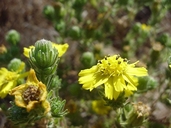Taxon Details
Deinandra increscens ssp. villosa
Gaviota tarplant
View Report Copy Link Calflora eFlora CCH CalPhotos iNaturalist
Taxon Summary:
Deinandra increscens ssp. villosa, commonly known as Gaviota tarplant, is a annual herb in the Asteraceae that is found only in California. It occurs within Coastal bluff scrub, Coastal scrub, and Valley and foothill grassland, growing at elevations from 20 to 430 meters. Deinandra increscens ssp. villosa is ranked 1B.1, Plants Rare, Threatened or Endangered in California and Elsewhere; Seriously threatened in California.|
Scientific Name: Deinandra increscens (Keck) B.G. Baldwin ssp. villosa (Tanowitz) B.G. Baldwin |
||
|
Common Name: Gaviota tarplant |
||
| Family: | Asteraceae | |
| Element Code: | PDAST4R0U3 | |
| USDA Plants Symbol: | DEINV3 | |
|
Synonyms/Other Names: |
||
| Name Status: |
JEF, FNA, POWO, IPNI, Tropicos |
|
| CA Rare Plant Rank: | 1B.1 |
| Fed List: | FE (2000-03-20) |
| State List: | CE (1990-01-01) |
| Global Rank: | G3T2 |
|
State Rank: |
S2 |
| Other Status: | SB_CalBG/RSABG; SB_SBBG |
|
CRPR Changes: |
|
| Add Date: | 1988-01-01 |
| Date Edited: | 2025-10-29 |
| Lifeform: annual herb | ||||||||||||||
Blooming Period: May-Oct
|
||||||||||||||
|
Elevation:
20 - 430 meters 65 - 1410 feet |
||||||||||||||
General Habitats:
|
||||||||||||||
| Microhabitat Details: | ||||||||||||||
|
Microhabitat:
|
||||||||||||||
|
Notes: State and federally-listed as Hemizonia increscens ssp. villosa; see this name in TJM (1993). See Systematic Botany 7(3):314-339 (1982) for original description, and Novon 9:462-471 (1999) for revised nomenclature. |
|
|
Threats: Seriously threatened by energy development and non-native plants. |
|
|
Taxonomy: |
|
| Threat List Total: | 13 | |
| Total EOs | % of EOs | |
| EOs with Threat Listed: | 14 | 67 % |
| THREAT LIST: | ||
|---|---|---|
| Development | 7 | 33% |
| Non-native plant impacts | 6 | 28% |
| Road/trail construction/maint. | 5 | 23% |
| Grazing | 5 | 23% |
| Foot traffic/trampling | 4 | 19% |
| Erosion/runoff | 4 | 19% |
| Other | 4 | 19% |
| ORV activity | 2 | 9% |
| Feral pigs | 2 | 9% |
| Disking | 2 | 9% |
| Agriculture | 1 | 4% |
| Biocides | 1 | 4% |
| Recreational use (non-ORV) | 1 | 4% |
| Total Occurrences: | 21 | ||||
| Element Occurrence Ranks: | |||||
|---|---|---|---|---|---|
| A | B | C | D | X | U |
| 0 | 9 | 2 | 1 | 0 | 9 |
| Occurrence Status: | |||||
|---|---|---|---|---|---|
| Historical >20 Years | 10 | ||||
| Recent <=20 Years | 11 | ||||
| Presence: | |||||
|---|---|---|---|---|---|
| Presumed Extant | 21 | ||||
| Possibly Extirpated | 0 | ||||
| Presumed Extirpated | 0 | ||||
| California Endemic: | |||||||||||||
| California Island: | |||||||||||||
|
States: Name (Code) California (CA) |
|||||||||||||
|
California Counties and Islands: Name (Code) Santa Barbara (SBA) |
|||||||||||||
|
Quads: Name (Quad Code) Casmalia (3412075), Gaviota (3412042), Guadalupe (3412085), Lompoc Hills (3412054), Point Arguello (3412056)?, Point Conception (3412044), Point Sal (3412086), Sacate (3412043), Tranquillon Mtn. (3412055) |
|||||||||||||
Notes:
|
|||||||||||||
 Presumed Extant
Presumed Extant
Click on quad for name. Hold Shift Key to use mouse scroll wheel



